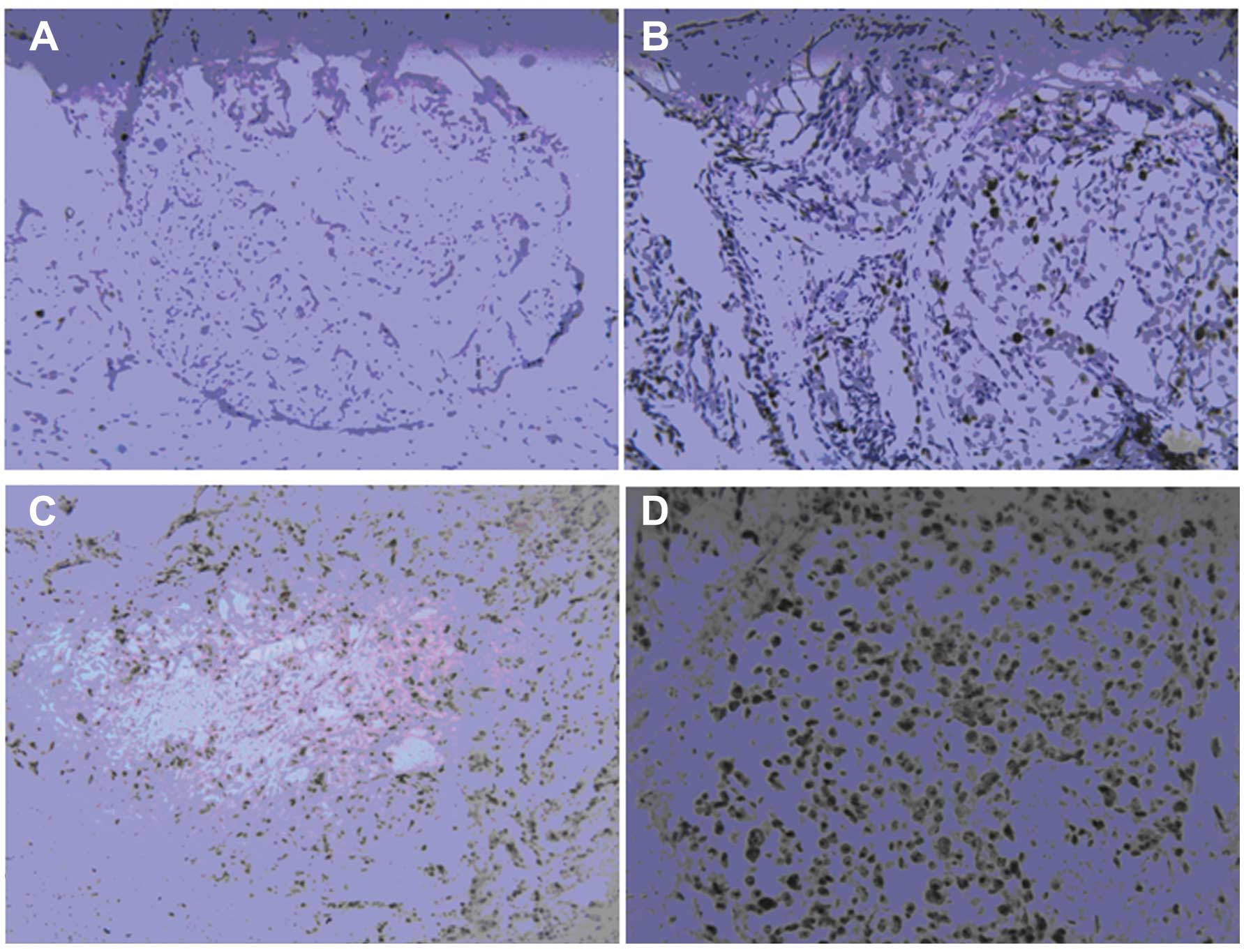|
1
|
Jemal A, Bray F, Center MM, Ferlay J, Ward
E and Forman D: Global cancer staristics. CA Cancer J Clin.
61:69–90. 2011. View Article : Google Scholar : PubMed/NCBI
|
|
2
|
Liu M, Lawson G, Delos M, et al:
Predictive value of the fraction of cancer cells immunolabeled for
proliferating cell nuclear antigen or Ki67 in biopsies of head and
neck carcinomas to identify lymph node metastasis: comparison with
clinical and radiologic examinations. Head Neck. 25:280–288. 2003.
View Article : Google Scholar : PubMed/NCBI
|
|
3
|
Lund MJ, Trivers KF, Porter PL, et al:
Race and triple negative threats to breast cancer survival: a
population-based study in Atlanta, GA. Breast Cancer Res Treat.
113:357–370. 2009. View Article : Google Scholar
|
|
4
|
Banerjee S, Reis-Filho JS, Ashley S, et
al: Basal-like breast carcinomas: clinical outcome and response to
chemotherapy. J Clin Pathol. 59:729–735. 2006. View Article : Google Scholar : PubMed/NCBI
|
|
5
|
Carey LA, Dees EC, Sawyer L, et al: The
triple negative paradox: primary tumor chemosensitivity of breast
cancer subtypes. Clin Cancer Res. 13:2329–2334. 2007. View Article : Google Scholar : PubMed/NCBI
|
|
6
|
Bauer KR, Brown M, Cress RD, Parise CA and
Caggiano V: Descriptive analysis of estrogen receptor
(ER)-negative, progesterone receptor (PR)-negative, and
HER2-negative invasive breast cancer, the so-called triple-negative
phenotype: a population-based study from the California cancer
Registry. Cancer. 109:1721–1728. 2007. View Article : Google Scholar : PubMed/NCBI
|
|
7
|
Carey LA, Perou CM, Livasy CA, et al:
Race, breast cancer subtypes, and survival in the Carolina Breast
Cancer Study. JAMA. 295:2492–2502. 2006. View Article : Google Scholar : PubMed/NCBI
|
|
8
|
Dent R, Trudeau M, Pritchard KI, et al:
Triple-negative breast cancer: clinical features and patterns of
recurrence. Clin Cancer Res. 13:4429–4434. 2007. View Article : Google Scholar : PubMed/NCBI
|
|
9
|
Edge S, Byrd DR, Compton CC, et al: AJCC
Cancer Staging Manual. 7th edition. Springer; Berlin, Germany:
2010
|
|
10
|
Harvey JM, Clark GM, Osbome CK and Allred
DC: Estrogen receptor status by immunohistochemistry is superior to
the ligand-binding assay for predicting response to adjuvant
endocrine therapy in breast cancer. J Clin Oncol. 17:1474–1481.
1999.PubMed/NCBI
|
|
11
|
Wolff AC, Hammond ME, Schwartz JN, et al:
American Society of Clinical Oncology/College of American
Pathologists guideline recommendations for human epidermal growth
factor testing in breast cancer. J Clin Oncol. 25:118–145. 2007.
View Article : Google Scholar
|
|
12
|
Rhee J, Han SW, Oh DY, et al: The
clinicopathologic characteristics and prognostic significance of
triple-negativity in node-negative breast cancer. BMC Cancer.
8:3072008. View Article : Google Scholar : PubMed/NCBI
|
|
13
|
Tamimi RM, Colditz GA, Hazra A, et al:
Traditional breast cancer risk factors in relation to molecular
subtypes of breast cancer. Breast Cancer Res Treat. 131:159–167.
2012. View Article : Google Scholar
|
|
14
|
Goldhirsch A, Wood WC, Coates AS, et al:
Strategies for subtypes - dealing with the diversity of breast
cancer: highlights of the St. Gallen International Expert Consensus
on the Primary Therapy of Early Breast Cancer 2011. Ann Oncol.
22:1736–1747. 2011. View Article : Google Scholar : PubMed/NCBI
|
|
15
|
Prat A, Cheang MC, Martín M, et al:
Prognostic significance of progesterone receptor-positive tumor
cells within immunohistochemically defined luminal A breast cancer.
J Clin Oncol. 31:203–209. 2013. View Article : Google Scholar :
|
|
16
|
Dawood S, Hu R, Homes MD, et al: Defining
breast cancer prognosis based on molecular phenotypes: results from
a large cohort study. Breast Cancer Res Treat. 126:185–192. 2011.
View Article : Google Scholar :
|
|
17
|
Wang GS, Zhu H and Bi SJ: Pathological
features and prognosis of different molecular subtypes of breast
cancer. Mol Med Report. 6:779–782. 2012.
|
|
18
|
Dey N, Smith BR and Leyland-Jones B:
Targeting basal-like breast cancers. Curr Drug Targets.
13:1510–1524. 2012. View Article : Google Scholar : PubMed/NCBI
|
|
19
|
Masuda N, Yasojima H, Mizutani M and
Yamamura J: Current status and future perspectives for the
treatment of triple-negative breast cancer in Japan. Gan To Kagaku
Ryoho. 39:512–518. 2012.(In Japanese). PubMed/NCBI
|
|
20
|
Yerushalmi R, Woods R, Ravdin PM, Hayes MM
and Gelmon KA: Ki67 in breast cancer: prognostic and predictive
potential. Lancet Oncol. 11:174–183. 2010. View Article : Google Scholar : PubMed/NCBI
|
|
21
|
Masuda H, Masuda N, Kodama Y, et al:
Predictive factors for the effectiveness of neoadjuvant
chemotherapy and prognosis in triple-negative breast cancer
patients. Cancer Chemother Pharmacol. 67:911–917. 2011. View Article : Google Scholar
|
|
22
|
Zheng JN, Ma TX, Cao JY, et al: Knockdown
of Ki-67 by small interfering RNA leads to inhibition of
proliferation and induction of apoptosis in human renal carcinoma
cells. Life Sci. 78:724–729. 2006. View Article : Google Scholar
|
|
23
|
Selz J, Stevens D, Jouanneau L, Labib A
and Le Scodan R: Prognostic value of molecular subtypes, ki67
expression and impact of postmastectomy radiation therapy in breast
cancer patients with negative lymph nodes after mastectomy. Int J
Radiat Oncol Bio Phys. 84:1123–1132. 2012. View Article : Google Scholar
|
|
24
|
Bhatavdekar JM, Patel DD, Shah NG, et al:
Prognostic significance of immunohistochemically localized
biomarkers in stage II and stage III breast cancer: a multivariate
analysis. Ann Surg Oncol. 7:305–311. 2000. View Article : Google Scholar : PubMed/NCBI
|










